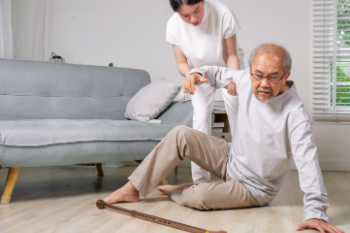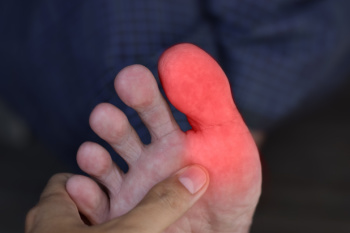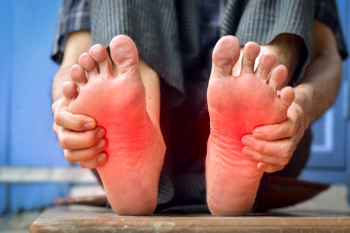
Falls at home often occur because of poor balance, reduced foot strength, or problems with sensation in the feet. When the muscles, joints, or nerves in the feet and ankles are weak or painful, balance can become unstable, increasing the chance of tripping. Wearing shoes that lack adequate support, such as flip-flops or worn-out slippers, can also make the feet more vulnerable to slipping. Proper footwear with firm soles and a secure fit helps improve stability and reduce strain on the arches and ankles. People with neuropathy, bunions, or arthritis can have difficulty sensing uneven ground or adjusting quickly to changes in surface texture. A podiatrist can assess foot strength, check for nerve or circulation problems, prescribe custom orthotics to improve balance, and recommend footwear that supports safer walking. If you are at risk for falling, it is suggested that you make an appointment with a podiatrist for a diagnosis and treatment.
Preventing falls among the elderly is very important. If you are older and have fallen or fear that you are prone to falling, consult with Robert Dunne, DPM from Lake Washington Foot and Ankle Center. Our doctor will assess your condition and provide you with quality advice and care.
Every 11 seconds, an elderly American is being treated in an emergency room for a fall related injury. Falls are the leading cause of head and hip injuries for those 65 and older. Due to decreases in strength, balance, senses, and lack of awareness, elderly persons are very susceptible to falling. Thankfully, there are a number of things older persons can do to prevent falls.
How to Prevent Falls
Some effective methods that older persons can do to prevent falls include:
- Enrolling in strength and balance exercise program to increase balance and strength
- Periodically having your sight and hearing checked
- Discuss any medications you have with a doctor to see if it increases the risk of falling
- Clearing the house of falling hazards and installing devices like grab bars and railings
- Utilizing a walker or cane
- Wearing shoes that provide good support and cushioning
- Talking to family members about falling and increasing awareness
Falling can be a traumatic and embarrassing experience for elderly persons; this can make them less willing to leave the house, and less willing to talk to someone about their fears of falling. Doing such things, however, will increase the likelihood of tripping or losing one’s balance. Knowing the causes of falling and how to prevent them is the best way to mitigate the risk of serious injury.
If you have any questions, please feel free to contact our offices located in Melbourne and Palm Bay, FL . We offer the newest diagnostic and treatment technologies for all your foot care needs.

A foot corn is a thickened area of skin that forms in response to repeated pressure or friction. A corn often develops on the toes or sides of the feet and becomes painful when walking or wearing tight shoes. Corns can be caused by wearing ill-fitting shoes, abnormal foot structure, or repeated rubbing against a shoe surface. Risk factors include spending long hours on your feet, wearing high heels, or having foot deformities that alter pressure points. A podiatrist can safely remove corns, address the underlying cause, and offer guidance on proper footwear and preventative care. A foot corn can be painful and can cause difficulty completing daily tasks. If you have this condition, it is suggested that you consult a podiatrist who can offer relief and prevention tips.
Corns can make walking very painful and should be treated immediately. If you have questions regarding your feet and ankles, contact Robert Dunne, DPM of Lake Washington Foot and Ankle Center. Our doctor will treat your foot and ankle needs.
Corns: What Are They? And How Do You Get Rid of Them?
Corns are thickened areas on the skin that can become painful. They are caused by excessive pressure and friction on the skin. Corns press into the deeper layers of the skin and are usually round in shape.
Ways to Prevent Corns
There are many ways to get rid of painful corns such as:
- Wearing properly fitting shoes that have been measured by a professional
- Wearing shoes that are not sharply pointed or have high heels
- Wearing only shoes that offer support
Treating Corns
Although most corns slowly disappear when the friction or pressure stops, this isn’t always the case. Consult with your podiatrist to determine the best treatment option for your case of corns.
If you have any questions, please feel free to contact our offices located in Melbourne and Palm Bay, FL . We offer the newest diagnostic and treatment technologies for all your foot care needs.

Hallux rigidus is a form of arthritis that affects the joint at the base of the big toe, making it difficult to bend or push off while walking. Over time, the joint loses flexibility as cartilage wears down, leading to stiffness, swelling, and aching pain, especially during motion. Some people notice a bump forming on top of the toe joint, which can make wearing certain shoes uncomfortable. Because this joint plays a key role in balance and forward movement, even small limitations can affect overall mobility. Early treatment focuses on reducing joint stress with supportive footwear, custom orthotics, and anti-inflammatory care. In more advanced cases, surgery may help to restore comfort and function. If your big toe feels stiff or sore when walking, it is suggested that you see a podiatrist for evaluation and treatment options.
Toe pain can disrupt your daily activities. If you have any concerns, contact Robert Dunne, DPM of Lake Washington Foot and Ankle Center. Our doctor can provide the care you need to keep you pain-free and on your feet.
What Causes Toe Pain?
Most severe toe pain is caused due to a sports injury, trauma from dropping something heavy on the toe, or bumping into something rigid. Other problems can develop over time for various reasons.
Toe pain can be caused by one or more ailments. The most common include:
- Trauma
- Sports injury
- Wearing shoes that are too tight
- Arthritis
- Gout
- Corns and calluses
- Hammertoe
- Bunions
- Blisters
- Ingrown toenails
- Sprains
- Fractures (broken bones)
- Dislocations
When to See a Podiatrist
- Severe pain
- Persistent pain that lasts more than a week
- Signs of infection
- Continued swelling
- Pain that prevents walking
Diagnosis
In many cases the cause of toe pain is obvious, but in others, a podiatrist may want to use more advanced methods to determine the problem. These can range from simple visual inspections and sensation tests to X-rays and MRI scans. Prior medical history, family medical history, and any recent physical traumatic events will all be taken into consideration for a proper diagnosis.
Treatment
Treatments for toe pain and injuries vary and may include shoe inserts, padding, taping, medicines, injections, and in some cases, surgery. If you believe that you have broken a toe, please see a podiatrist as soon as possible.
If you have any questions please contact our offices located in Melbourne and Palm Bay, FL . We offer the newest diagnostic and treatment technologies for all your foot and ankle needs.

Foot pain that feels stiff, achy, or swollen may be more than simple fatigue. Arthritis can affect any of the many joints in the foot and ankle, leading to inflammation, limited movement, and discomfort that worsens with activity or changes in weather. Over time, the loss of joint cartilage can make even short walks difficult. A podiatrist can identify whether arthritis is the cause through examination and imaging, then recommend treatments to reduce pain and improve mobility. Custom orthotics, anti-inflammatory therapy, and wearing supportive footwear can help protect the joints and slow progression. Maintaining a healthy weight and staying active with low-impact exercise can also make a difference. If your foot pain is persistent or accompanied by swelling and stiffness, it is suggested you schedule an appointment with a podiatrist for a proper diagnosis and appropriate treatment.
Arthritis can be a difficult condition to live with. If you are seeking treatment, contact Robert Dunne, DPM from Lake Washington Foot and Ankle Center. Our doctor can provide the care you need to keep you pain-free and on your feet.
Arthritic Foot Care
Arthritis is a joint disorder that involves the inflammation of different joints in your body, such as those in your feet. Arthritis is often caused by a degenerative joint disease and causes mild to severe pain in all affected areas. In addition to this, swelling and stiffness in the affected joints can also be a common symptom of arthritis.
In many cases, wearing ill-fitting shoes can worsen the effects and pain of arthritis. Wearing shoes that have a lower heel and extra room can help your feet feel more comfortable. In cases of rheumatoid arthritis, the arch in your foot may become problematic. Buying shoes with proper arch support that contour to your feet can help immensely.
Alleviating Arthritic Pain
- Exercises that stretch the foot can prevent further pain and injury and increase mobility
- Most of the pain can be alleviated with anti-inflammatory drugs, heat, and topical medications
- Massages can help temporarily alleviate pain.
It is best to see your doctor for the treatment that is right for your needs and symptoms. Conditions vary, and a podiatrist can help you determine the right method of care for your feet.
If you have any questions please feel free to contact our offices located in Melbourne and Palm Bay, FL . We offer the newest diagnostic tools and technology to treat your foot and ankle needs.
